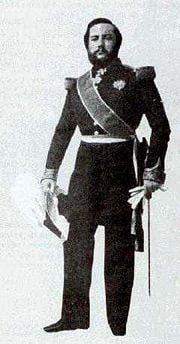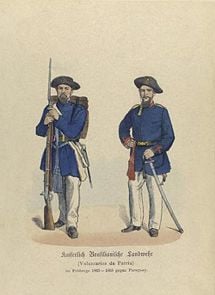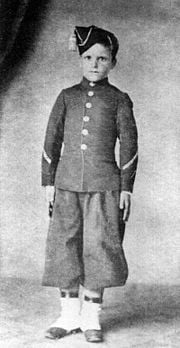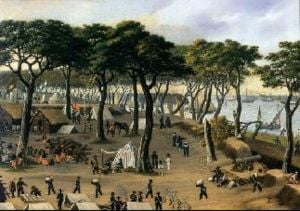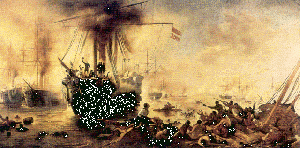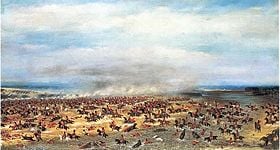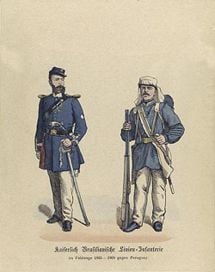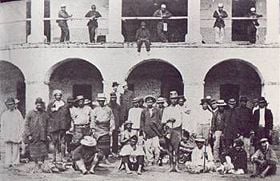War of the Triple Alliance
| War of the Triple Alliance | |||||||
|---|---|---|---|---|---|---|---|
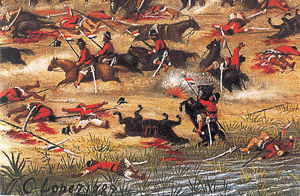 Battle of Tuyutí was the bloodiest battle in the history of South America | |||||||
| |||||||
| Combatants | |||||||
| Commanders | |||||||
22px Duke of Caxias | |||||||
| Strength | |||||||
| at the beginning of the war ca. 50,000 | at the beginning of the war ca. 26,000 | ||||||
| Casualties | |||||||
| ca. 300,000 soldiers and civilians | 90,000 to 100,000 soldiers and civilians | ||||||
The War of the Triple Alliance, also known as the Paraguayan War (or in native Guaraní, Guerra Guazú, meaning “Great War”), was fought from 1864 to 1870, and was by some measures the bloodiest conflict in the history of South America. It was fought between Paraguay and the allied countries of Argentina, Brazil, and Uruguay, from which the name "Triple Alliance" came.
The cause of the war has been widely attributed to causes as varied as the after–effects of colonialism in Latin America, the struggle for physical power over the strategic Rio de la Plata region, Paraguay's boundary and tariff disputes with Argentina and Brazil, British economic interests in the region, and the expansionist ambitions of Paraguayan dictator Francisco Solano López.
| War of the Triple Alliance |
|---|
| Mato Grosso – Rio Grande do Sul – Corrientes – Riachuelo – Jataí – Tuyutí – Curupaity – Piquissiri – Campaign of the Hills – Cerro Corá – Acosta Ñu |
The effects of the war were devastating to Paraguay. Having been fanatically committed to their nation's leader and thus the war effort, they fought to the point of essential disintegration. The population was decimated by more than half through malnutrition and disease as well as warfare itself. López committed atrocities against his own people, torturing and killing countless citizens.
Argentina and Brazil annexed about 55,000 square miles of Paraguay, which remained occupied until 1876. Paraguay, more than 130 years after the conclusion of the war, remains one of the poorest nations on the continent.
The setup
Paraguay before the war
Historians have long considered that Paraguay under José Gaspar Rodríguez de Francia (1813–1840) and Carlos Antonio López (1841–1862) developed quite differently from other South American countries. The aim of Rodríguez de Francia and Carlos López is understood to have been the encouragement of self-sufficient economic development through isolation from neighboring countries.[1] However, in the 1960s and 1970s, some historians began to claim that the War of the Triple Alliance was caused by pseudo-colonial influence of the British who were in need of a new source of cotton due to the United States Civil War.
The rule of the López family was characterized by a strict centralism that did not recognize any distinction between the public and the private spheres. Paraguay under the López family was ruled more similarly to large property estate than that of a nation.[2]
Exports were controlled by the government. The yerba mate and valuable wood exported maintained the balance of commerce. Due to extremely high tariffs, the entrance of foreign products did not occur.
Francisco Solano López, son of Carlos Antonio López, replaced his father as ruler in 1862. Young López never married; however, at the age of 18 during a trip to Paris to purchase arms, he met and fell in love with an Irish woman named Elisa Alicia Lynch, who would become his mistress and give birth to his five sons. She was known as “La Lynch” to the locals and became a highly influential trendsetter in Asunción. During the War of the Triple Alliance, Solano López transferred most of the country and portions of Brazil to her name, making her the largest landowner in Paraguay; yet by the war’s end, she retained almost nothing.
Solano López generally continued the political policies of his predecessors, but he would first silence several hundred of his critics by imprisonment. In the area of the military, he modernized and expanded in ways that eventually would lead to war.[3] More than 200 foreign technicians, hired by the government, installed telegraph lines and railroads to aid the steel, textiles, paper, ink, naval construction, and gunpowder industries. The Ibicuí foundry, installed in 1850, manufactured cannons, mortars, and bullets of all calibers. Warships were built in the Asunción shipyards.
This growth required contact with the international market, but Paraguay was landlocked. Its ports were river ports and ships had to travel down the Paraguay and the Paraná rivers to reach the estuary of the Rio de la Plata and the ocean. Solano López conceived a project to obtain a port in the Atlantic Ocean: The capturing of a slice of Brazilian territory that would link Paraguay to the coastline.[4]
To maintain his expansionist intentions, López began to prepare Paraguay's military. He encouraged the industry of war, mobilized a large quantity of men for the army (mandatory military service already existed in Paraguay), submitted them to intensive military training, and built fortifications at the mouth of the Paraguay River.
Diplomatically, Solano López wanted to ally himself with Uruguay's ruling Blanco Party. The Colorados were tied to Brazil and Argentina.[5]
River Plate politics
Since Brazil and Argentina had become independent, the fight between the governments of Buenos Aires and of Rio de Janeiro for hegemony in the River Plate basin profoundly marked the diplomatic and political relations between the countries of the region.[6] The two nations nearly engaged in war twice.
The government of Buenos Aires, Argentina, sought to reconstruct the territory of the old Viceroyalty of the River Plate, enclosing the nations of Paraguay and Uruguay. It carried out diverse attempts to do so during the first half of the nineteenth century, without success, many times due to the intervention of Brazil. Fearing excessive Argentine control, Brazil favored a balance of power in the region, helping Paraguay and Uruguay retain their sovereignty.
Brazil, under the rule of Portugal, was the first country to recognize the independence of Paraguay in 1811. While Argentina was ruled by Juan Manuel Rosas (1829–1852), a common enemy of both Brazil and Paraguay, Brazil contributed to the improvement of the fortifications and development of the Paraguayan army, sending officials and technical help to Asunción. As no roads linked the province of Mato Grosso to Rio de Janeiro, Brazilian ships needed to travel through Paraguayan territory, traveling up the Paraguay River to arrive at Cuiabá. Many times, however, Brazil had difficulty obtaining permission to sail from the government in Asunción.
Brazil carried out three political and military interventions in Uruguay:
- In 1851, against Manuel Oribe to fight Argentine influence in the country;
- In 1855, at the request of the Uruguayan government and Venancio Flores, leader of the Colorados, who were traditionally supported by the Brazilian empire; and,
- In 1864, against Atanásio Aguirre. This last intervention would be the fuse of the War of the Triple Alliance.
These interventions were aligned to the British desire for the fragmentation of the River Plate region to stop any attempt to monopolize the region's minerals.
Intervention against Aguirre
In April 1864, Brazil sent a diplomatic mission to Uruguay led by José Antônio Saraiva to demand payment for the damages caused to gaucho farmers in border conflicts with Uruguayan farmers. The Uruguayan president Atanásio Aguirre, of the National Party, refused the Brazilian demands.
Solano López offered himself as mediator, but was turned down by Brazil. López subsequently broke diplomatic relations with Brazil—in August 1864—and declared that the occupation of Uruguay by Brazilian troops would be an attack to the equilibrium of the River Plate region.
On October 12, Brazilian troops invaded Uruguay. The followers of the Colorado Venancio Flores, who had the support of Argentina, united with the Brazilian troops and deposed Aguirre.[7]
The war
The war begins
When attacked by Brazil, the Uruguayan Blancos asked for help from Solano López, but Paraguay did not directly come to their allies' aid. Instead, on November 12, 1864, the Paraguayan ship Tacuari captured the Brazilian ship Marquês of Olinda, which had sailed up the Paraguay River to the province of Mato Grosso.[8] Paraguay declared war on Brazil on December 13, and on Argentina three months later, on March 18, 1865. Uruguay, governed by Venancio Flores, aligned itself with Brazil and Argentina.
At the beginning of the war, the military force of the Triple Alliance was inferior to that of Paraguay, which included more than 60,000 well-trained men—38,000 of whom were immediately under arms—and a naval squadron of 23 vapores and five river-navigating ships, based around the gunboat the Tacuari.[9] Its artillery included approximately 400 cannons.
The armies of Brazil, Argentina, and Uruguay were a fraction of the total size of the Paraguayan army. Argentina had approximately 8,500 regular troops and a squadron of four vapores and one goleta. Uruguay entered the war with fewer than 2,000 men and no navy. Many of Brazil's 16,000 troops were initially located in its southern garrisons.[10] The Brazilian advantage, though, was in its navy: 42 ships with 239 cannons and about 4,000 well-trained crew. A great part of the squadron already met in the River Plate basin, where it had acted, under the Marquis of Tamandaré, in the intervention against Aguirre.
Though it had a sizable navy, Brazil was unprepared to fight a war. Its army was unorganized. The troops used in the interventions in Uruguay were composed merely of the armed contingents of gaucho politicians and some of the staff of the National Guard. The Brazilian infantry who fought in the War of the Triple Alliance were not professional soldiers but volunteers, the so-called Voluntários da Pátria. Many were slaves sent by farmers. The cavalry was formed from the National Guard of Rio Grande Do Sul.
Brazil, Argentina, and Uruguay would sign the Treaty of the Triple Alliance in Buenos Aires on May 1, 1865, allying the three River Plate countries against Paraguay, vowing to destroy the government of Solano López. They named Bartolomé Mitre, president of Argentina, as supreme commander of the allied troops.[11]
Paraguayan offensive
During the first phase of the war Paraguay took the initiative. The armies of López dictated the location of initial battles—invading Brazil’s Mato Grosso in the north in December 1864, Rio Grande do Sulin the southernmost part of Brazil in the first months of 1865, and the Argentine province of Corrientes. Two bodies of Paraguayan troops invaded Mato Grosso simultaneously. Due to the numerical superiority of the invaders the province was captured quickly.
Five thousand men, transported in ten ships and commanded by the colonel Vicente Barrios, traveled up the Paraguay River and attacked the fort of Nova Coimbra. The garrison of 155 men resisted for three days under the command of the lieutenant-colonel Hermenegildo de Albuquerque Port Carrero, later baron of Fort Coimbra. When the munitions were exhausted, the defenders abandoned the fort and withdrew up the river on board the gunship Anhambaí in direction of Corumbá. After they occupied the empty fort the Paraguayans advanced north taking the cities of Albuquerque and Corumbá in January 1865.
The second Paraguayan column, which was led by Colonel Francisco Isidoro Resquín and included four thousand men, penetrated a region south of Mato Grosso, and sent a detachment to attack the military frontier of Dourados. The detachment, led by Major Martín Urbieta, encountered tough resistance on December 29, 1864, from Lieutenant Antonio João Ribeiro and his 16 men, who perished without yielding. The Paraguayans continued to Nioaque and Miranda, defeating the troops of the colonel José Dias da Silva. Coxim was taken in April 1865.
The Paraguayan forces, despite their victories, did not continue to Cuiabá, the capital of the province. Augusto Leverger had fortified the camp of Melgaço to protect Cuiabá. The main objective was to distract the attention of the Brazilian government to the north as the war would lead to the south, closer to the River Plate estuary. The invasion of Mato Grosso was a diversionary maneuver.
The invasion of Corrientes and of Rio Grande do Sul was the second phase of the Paraguayan offensive. To raise the support of the Uruguayan Blancos, the Paraguayan forces had to travel through Argentine territory. In March of 1865, López sought the Argentine government's permission for an army of 25,000 men (led by General Wenceslao Robles) to travel through the province of Corrientes. The president, Bartolomé Mitre, an ally of Brazil in the intervention in Uruguay, refused.
On March 18, 1865, Paraguay declared war on Argentina. A Paraguayan squadron, coming down the Paraná River, imprisoned Argentine ships in the port of Corrientes. Immediately, General Robles's troops took the city.
In invading Corrientes, López attempted to obtain the support of the powerful Argentine caudillo Justo José de Urquiza, governor of the provinces of Corrientes and Entre Ríos, and the chief federalist hostile to Mitre and to the government of Buenos Aires.[12] But Urquiza assumed an ambiguous attitude towards the Paraguayan troops, which would advance nearly 124 miles (200 kilometers) south before ultimately ending the offensive in failure.
Along with Robles's troops, a force of 10,000 men under the orders of the lieutenant-colonel Antonio de la Cruz Estigarriba crossed the Argentine border south of Encarnación, in May 1865, driving for Rio Grande do Sul. They traveled down the Uruguay River and took the town of São Borja on June 12. Uruguaiana, to the south, was taken on August 5th without any significant resistance.
Brazil reacts
Brazil sent an expedition to fight the invaders in Mato Grosso. A column of 2,780 men led by Colonel Manuel Pedro Drago left Uberaba in Minas Gerais in April 1865, and arrived at Coxim in December after a difficult march of more than two thousand kilometers through four provinces, but Paraguay had abandoned Coxim by December. Drago arrived at Miranda in September 1866, to find that Paraguay had left once again. In January 1867, Colonel Carlos de Morais Camisão assumed command of the column, now only 1,680 men, and decided to invade Paraguayan territory, where he penetrated into Laguna. The expedition was forced to retreat by the Paraguayan cavalry.
Despite the efforts of Colonel Camisão's troops and the resistance in the region, which succeeded in liberating Corumbá in June 1867, Mato Grosso remained under the control of the Paraguayans. They finally withdrew in April 1868, moving their troops to the main theater of operations, in the south of Paraguay.
Communications in the Rio de la Plata basin was solely by river; few roads existed. Whoever controlled the rivers would win the war, so the Paraguayan fortifications had been built on the edges of the lower end of the Paraguay River.
The naval battle of Riachuelo occurred on June 11, 1865. The Brazilian fleet commanded by Francisco Manoel Barroso da Silva won, destroying the powerful Paraguayan navy and preventing the Paraguayans from permanently occupying Argentine territory. The battle essentially decided the outcome of the war in favor of the Triple Alliance, which controlled, from that point on, the rivers of the Rio de la Plata basin up to the entrance to Paraguay.[13]
While López ordered the retreat of the forces that occupied Corrientes, the Paraguayan troops that invaded São Borja advanced, taking Itaqui and Uruguaiana. A separate division of 3,200 men continued toward Uruguay under the command of the major Pedro Duarte but was defeated by Flores in the bloody battle of Jataí on the banks of the Uruguay River.
The allied troops united under the command of Mitre in the camp of Concórdia, in the Argentine province of Entre Ríos, with the field-marshall Manuel Luís Osório at the front of the Brazilian troops. Part of the troops, commanded by the lieutenant-general Manuel Marques de Sousa, baron of Porto Alegre, left to reinforce Uruguaiana. The Paraguayans yielded on September 18, 1865.
In the subsequent months, the Paraguayans were driven out of the cities of Corrientes and San Cosme, the only Argentine territory still in Paraguayan possession. By the end of 1865, the Triple Alliance was on the offensive. Their armies numbered more than 50,000 men and were prepared to invade Paraguay.
Invasion of Paraguay
The invasion of Paraguay followed the course of the Paraguay River, from the Paso de la Patria. From April 1866 to July 1868, military operations concentrated in the confluence of the rivers Paraguay and Paraná, where the Paraguayans located their main fortifications. For more than two years, the advance of the invaders was blocked, despite initial Triple Alliance victories.
The first stronghold taken was Itapiru. After the battles of the Paso de la Patria and of the Estero Bellaco, the allied forces camped on swamps of Tuyutí, where they were attacked. The first battle of Tuyutí, won by the allies on May 24, 1866, was the biggest battle in the history of South America.
Due to health reasons, in July 1866, Osório passed the command of the First Corps of the Brazilian army to General Polidoro da Fonseca Quintanilha Jordão. At the same time, the Second Corps—10,000 men—arrived at the theater of operations, brought from Rio Grande Do Sul by the baron of Porto Alegre.
To open the way to Humaitá, the biggest Paraguayan stronghold, Mitre attacked the batteries of Curuzu and Curupaity. Curuzu was taken by surprise by the baron of Porto Alegre, but on the morning of September 22, 1866, when the joint forces of the Brazilian and Argentine armies attacked Paraguay’s fortified trenches on Curupaity led by General José E. Díaz, their position was held by 5,000 men and 49 cannons. The Brazilian Navy gave support to the 20,000 assailants, but the ships were forced to keep some distance from the guns at the fortress of Humaitá, which led to the lack of accuracy and impact of the ship's fire. Nearly 20 percent of the almost 20,000 allied (Brazilian and Argentine) troops involved in the attack were lost; Paraguay lost less than one hundred men. The failure of this battle resulted in the change of the allied command.
Paraguay's biggest success in the ultimately disastrous War of the Triple Alliance was limited because its military leader, Francisco Solano López, didn't counterattack the defeated allies. Not even a general as celebrated as Díaz would attack without López's orders. Ultimately, the battle of Curupayty was merely a side note and temporary success in what would eventually become a near-extermination of the Paraguayan people.
During this phase of the war, many Brazilian servicemen distinguished themselves, amongst them, the heroes of Tuyutí: General José Luís Mena Barreto; Brigadier General Antônio de Sampaio, protector of the infantry weapons of the Brazilian Army; Lieutenant Colonel Emílio Luís Mallet, head of the artillery; and even Osório, head of the cavalry. In addition, Lieutenant Colonel João Carlos of Vilagrã Cabrita, head of weapons of engineering, died in Itapiru.
Caxias in command
Assigned on October 10, 1866, to command the Brazilian forces, Marshall Luís Alves de Lima e Silva, Marquis and, later, Duke of Caxias, arrived in Paraguay in November, finding the Brazilian army practically paralyzed. The contingent of Argentines and Uruguayans, devastated by disease, were cut off from the rest of the allied army. Mitre and Flores returned to their respective countries due to questions of internal politics. Tamandaré was replaced in command by the admiral Joaquim José Inácio, future Viscount of Inhaúma. Osório organized a 5,000-strong third Corps of the Brazilian army in Rio Grande do Sul. In Mitre's absence, Caxias assumed the general command and restructured the army.
Between November 1866 and July 1867, Caxias organized a health corps to give aid to the endless number of injured soldiers and to fight the epidemic of cholera as well as a system of supplying the troops. During that period, military operations were limited to skirmishes with the Paraguayans and to bombarding Curupaity. López took advantage of the disorganization of the enemy to reinforce his stronghold in Humaitá.
The march to flank the left wing of the Paraguayan fortifications constituted the basis of Caxias's tactics. Caxias wanted to bypass the Paraguayan strongholds, cut the connections between Asunción and Humaitá, and finally circle the Paraguayans. To this end, Caxias marched to Tuiu-Cuê. But Mitre, who had returned to the command in August 1867, insisted on attacking by the right wing, a strategy that had previously been disastrous in Curupaity. By his order, the Brazilian squadron forced its way past Curupaity but was forced to stop at Humaitá. New splits in the high command arose: Mitre wanted to continue, but the Brazilians instead captured São Solano, Pike, and Tayi, isolating Humaitá from Asunción. In reaction, López attacked the rearguard of the allies in Tuiuti, but suffered new defeats.
With the removal of Mitre in January 1868, Caxias reassumed the supreme command and decided to bypass Curupaity and Humaitá, carried out with success by the squadron commanded by Captain Delfim Carlos de Carvalho, later Baron of Passagem. Humaitá fell on July 25, after a long siege.
En route to Asunción, Caxias's army went 124 miles (200 kilometers) to Palmas, stopping at the Piquissiri river. There, López had concentrated 18,000 Paraguayans in a fortified line that exploited the terrain and supported the forts of Angostura and Itá-Ibaté. Resigned to frontal combat, Caxias ordered the so-called Piquissiri maneuver. While a squadron attacked Angostura, Caxias made the army cross on the right side of the river. He ordered the construction of a road in the swamps of the Chaco, upon which the troops advanced to the northeast. At Villeta, the army crossed the river again, between Asunción and Piquissiri, behind the fortified Paraguayan line. Instead of advancing to the capital, already evacuated and bombarded, Caxias went south and attacked the Paraguayans from behind.
Caxias had obtained a series of victories in December 1868, when he returned south to take Piquissiri from the rear, capturing Itororó, Avaí, Lomas Valentinas, and Angostura. On December 24, the three new commanders of the Triple Alliance (Caxias, the Argentines Gelly and Obes, and the Uruguayan Enrique Castro) sent a note to Solano López asking for surrender. López refused and fled for Cerro Leon.
Asunción was occupied on January 1, 1869, by commands of Colonel Hermes Ernesto da Fonseca, father of the future Marshall Hermes da Fonseca. On the fifth day, Caxias entered in the city with the rest of the army and 13 days later left his command.
The end of the war
Command of Count d'Eu
The son-in-law of the emperor Dom Pedro II, Luís Filipe Gastão de Orléans, Count d'Eu, was nominated to direct the final phase of the military operations in Paraguay. He sought not just a total rout of Paraguay, but also the strengthening of the Brazilian Empire. In August 1869, the Triple Alliance installed a provisional government in Asunción headed by Paraguayan Cirilo Antonio Rivarola.
Solano López organized the resistance in the mountain range northeast of Asunción. At the head of 21,000 men, Count d'Eu led the campaign against the Paraguayan resistance, the Campaign of the Mountain Range, which lasted over a year. The most important battles were the battles of Piribebuy and of Acosta Ñu, in which more than 5,000 Paraguayans died.
Two detachments were sent in pursuit of Solano López, who was accompanied by 200 men in the forests in the north. On March 1, 1870, the troops of General José Antônio Correia da Câmara surprised the last Paraguayan camp in Cerro Corá, where Solano López was fatally injured by a spear as he tried to escape by swimming down the Aquidabanigui stream. His last words were: "Muero por mi patria" ("I die for my homeland"). His death marked the end of the War of the Triple Alliance.
Mortality
The Paraguayan people had been fanatically committed to López and the war effort, and as a result they fought to the point of dissolution. Paraguay suffered massive casualties, losing perhaps the majority of its population. The war left it utterly prostrate.
The specific numbers of casualties are hotly disputed, but it has been estimated that 300,000 Paraguayans, mostly civilians, died; up to 90 percent of the male population may have been killed. According to one numerical estimation, the prewar population of approximately 525,000 Paraguayans was reduced to about 221,000 in 1871, of which only about 28,000 were men. Definitively accurate casualty numbers will likely never be determined.
Of the around 123,000 Brazilians that fought in the War of the Triple Alliance, the best estimates say that around 30,000 died on the battlefield, while another 30,000 from disease. In the province of Mato Grosso, civilian casualties were especially high, with an estimate of 5,000 out of a population of 75,000. Uruguayan forces counted barely 5,600 men (some of whom were foreigners), of whom about 3,100 died. Argentina’s death toll range from 27,000 to 30,000; 18,000 from combat and another 12,000 from disease.
The high rates of mortality were not strictly the result of the armed conflict in itself. Bad food hygiene caused a high percentage of the deaths. Among the Brazilians, many of the casualties died in hospitals and during the march, before ever facing the enemy. In the beginning of the conflict, most of the Brazilian soldiers came from the north and northeast regions of the country; the changes from a hot to cold climate and the amount of food available to them were abrupt. Drinking the river water was sometimes fatal to entire battalions of Brazilians. Cholera was, perhaps, the main cause of death during the war.
Consequences of the war
Following Paraguay's final defeat in 1870, Argentina sought to enforce one of the secret clauses of the Triple Alliance Treaty, according to which Argentina would receive a large part of the Gran Chaco, a Paraguayan region rich in quebracho (a product used in the tanning of leather). The Argentinean negotiators proposed to Brazil that Paraguay should be divided in two, with each of the victors incorporating a half into its territory. The Brazilian government, however, was not interested in the end of the Paraguayan state, since it served as a cushion between the Brazilian Empire and Argentina.
A standstill began, and the Brazilian army, which was in complete control of the Paraguayan territory, remained in the country for six years after the final defeat of Paraguay in 1870, only leaving in 1876, in order to ensure the continued existence of Paraguay. During this time, the possibility of an armed conflict with Argentina for control over Paraguay became increasingly real, as Argentina wanted to seize the Chaco region, but was barred by the Brazilian Army.
No single overall peace treaty was signed. The post-war border between Paraguay and Argentina was resolved through long negotiations, finalized in a treaty that defined the frontier between the two countries signed on February 3, 1876, and which granted Argentina roughly a third of the area it had intended to incorporate originally. The only region about which no consensus was reached, the area between the Río Verde and the main branch of Río Pilcomayo, was arbitrated by U.S. President Rutherford B. Hayes, who declared it Paraguayan.
Brazil signed a separate peace treaty with Paraguay on January 9, 1872, obtaining freedom of navigation on the Paraguay River. Brazil received the borders it had claimed before the war. The treaty also stipulated a war debt to the imperial government of Brazil that was eventually pardoned in 1943, by Getúlio Vargas in reply to a similar Argentine initiative.
In December 1975, when the presidents Ernesto Geisel and Alfredo Stroessner signed in Asunción a Treaty of Amity and Cooperation, the Brazilian government returned its spoils of war to Paraguay.
The war remains a controversial topic, especially in Paraguay, where it is considered either a fearless struggle for the rights of a smaller nation against the aggressions of more powerful neighbors, or a foolish attempt to fight an unwinnable war that nearly destroyed a whole nation.
The Paraguayan villages destroyed by the war were abandoned and the survivors migrated to the outskirts of Asunción, dedicating themselves to subsistence agriculture and continued artisan production by many of the women in the central region of the country in unimaginable conditions. Paraguayan industry collapsed. Any modernization of the preceding three decades was undone and this once self-sufficient nation, whose quality of life and advances in agriculture were envied by its neighbors, became the most backward nation in the Southern Cone.
Immigrants from Europe, greatly encouraged by the government, and former Brazilian soldiers were slowly repopulating the country. Lands were sold to foreigners, mainly Argentines, and turned into estates. The Paraguayan market opened itself to British products and the country was forced for the first time to obtain outside loans, totaling a million British pounds.
Argentina annexed part of Paraguayan territory and became the strongest of the River Plate countries. During the campaign, the provinces of Entre Ríos and Corrientes had supplied Brazilian troops with cattle, food, and other products.
Brazil paid a high price for victory. The war was financed by the Bank of London, and by Baring Brothers and N M Rothschild & Sons. During the five years of war, Brazilian expenditure reached twice its receipts, causing a financial crisis.
In total, Argentina and Brazil annexed about 55,000 square miles (140,000 km²) of Paraguayan territory: Argentina took much of the Misiones region and part of the Chaco between the Bermejo and Pilcomayo rivers; Brazil enlarged its Mato Grosso province by claiming territories that had been disputed with Paraguay before the war. Both demanded a large indemnity (which was never paid) and occupied Paraguay until 1876. Meanwhile, the Colorados had gained political control of Uruguay, which they retained until 1958.
Slavery was undermined in Brazil as slaves were freed to serve in the war. [14] The Brazilian army became a new and expressive force in national life. It transformed itself into a strong institution that, with the war, gained tradition and internal cohesion and would take a significant role in the later development of the history of the country.
The war took its biggest toll on the Brazilian emperor. The economic depression and the fortification of the army would later play a big role in the deposition of the emperor Dom Pedro II and the republic proclamation in 1889. General Deodoro da Fonseca would become the first Brazilian president.
Notes
- ↑ P.J. O'Rourke, Give War a Chance: Eyewitness Accounts of Mankind's Struggle Against Tyranny, Injustice, and Alcohol-Free Beer (New York: Atlantic Monthly Press, 2003, ISBN 0871135205), p. 47.
- ↑ Library of Congress Country Studies, Paraguay, Dictatorship and War, Carlos Antonio López. Retrieved May 25, 2007.
- ↑ Robert Cowley and Geoffrey Parker, The Reader's Companion to Military History (Boston: Houghton Mifflin, 1996, ISBN 0395669693), p. 479.
- ↑ Brandon Valeriano, A Classification of Interstate War: Typologies and Rivalry. Retrieved May 25, 2007.
- ↑ Scheina, 313-4.
- ↑ Whigwham, 118.
- ↑ Scheina, 314.
- ↑ Scheina, 313.
- ↑ Scheina, 315-7.
- ↑ Scheina, 318.
- ↑ Scheina, 319.
- ↑ Scheina, 319.
- ↑ Scheina, 320.
- ↑ Hendrick Kraay, The shelter of the uniform: The Brazilian army and runaway slaves, 1800-1888, FindArticles.com.
ReferencesISBN links support NWE through referral fees
- Country Studies. The War of the Triple Alliance. Retrieved May 24, 2007.
- Gomes, Carlos de Oliveira. 1980. A solidão segundo Solano López: romance(In Portuguese). Rio de Janeiro: Civilização Brasileira.
- Leuchars, Chris. 2002. To the Bitter End: Paraguay and the War of the Triple Alliance. Contributions in Military Studies. Westport, Conn: Greenwood Press. ISBN 0313323658.
- Pernidji, Joseph Eskenazi, and Maurício Eskenazi Pernidji. 2003. Homens e mulheres na Guerra do Paraguai(In Portuguese). Rio de Janeiro: Imago. ISBN 8531208998.
- Scheina, Robert L. 2003. Latin America's Wars: The Age of the Caudillo, 1791-1899. Washington, D.C.: Brassey's, Inc. ISBN 1574884492.
- Whigham, Thomas. 2002. The Paraguayan War. Lincoln, Neb: University of Nebraska Press. ISBN 0803247869.
External links
All links retrieved May 3, 2023.
- Guerra do Paraguai. (Portuguese Language). Meu Artigo.
- Conhecendo o Portal Sua Pesquisa. (Portuguese Language). Sua Pesquisa.
Credits
New World Encyclopedia writers and editors rewrote and completed the Wikipedia article in accordance with New World Encyclopedia standards. This article abides by terms of the Creative Commons CC-by-sa 3.0 License (CC-by-sa), which may be used and disseminated with proper attribution. Credit is due under the terms of this license that can reference both the New World Encyclopedia contributors and the selfless volunteer contributors of the Wikimedia Foundation. To cite this article click here for a list of acceptable citing formats.The history of earlier contributions by wikipedians is accessible to researchers here:
The history of this article since it was imported to New World Encyclopedia:
Note: Some restrictions may apply to use of individual images which are separately licensed.
